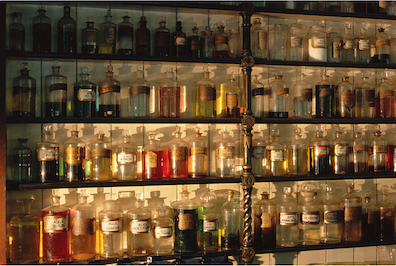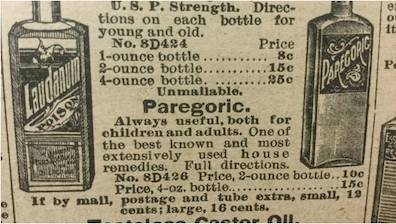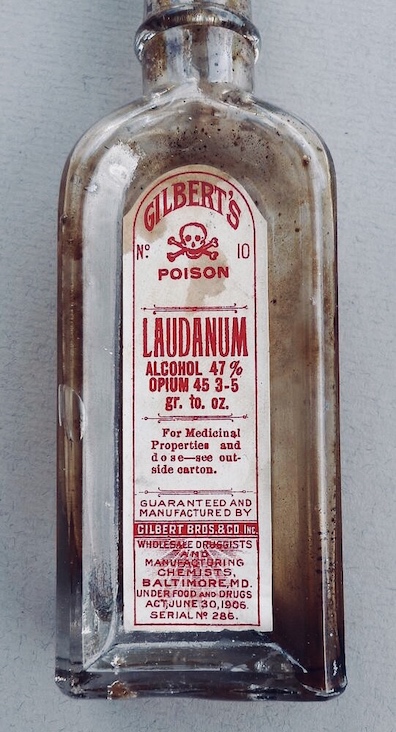In 1904 James Joyce walked into the pharmacy on Lincoln Place and
quizzed the proprietor, Frederick William Sweny, about
his business. This minor research foray no doubt gave him some
material for Bloom's reverie about the stuff on the shelves:
"Aq. Dist. Fol. Laur. Te Virid. Smell almost cure you like the
dentist's doorbell. Doctor Whack. He ought to physic himself a
bit. Electuary or emulsion. The first fellow that picked an
herb to cure himself had a bit of pluck. Simples. Want to be
careful. Enough stuff here to chloroform you. Test:
turns blue litmus paper red. Chloroform. Overdose of laudanum.
Sleeping draughts. Lovephiltres. Paragoric poppysyrup bad for
cough. Clogs the pores or the phlegm. Poisons the only cures.
Remedy where you least expect it. Clever of nature." Some of
the details here are neutral enough, but a thread of Odyssean
peril runs through the paragraph.
At the dawn of the 20th century pharmacology still relied
heavily on traditional herbal remedies, a fact which makes
Bloom think of the daring of the prehistoric humans who first
experimented with consuming potent leaves, berries, barks, and
roots. Pharmacies were stocked with numerous bottles, boxes,
and wooden drawers holding such ingredients. They were the "Simples"
which pharmacists compounded to make their various
preparations. (The OED notes that in medicine the term
means "Consisting or composed of one substance, ingredient, or
element...esp. natural or organic.") Many such herbal
ingredients in pharmacists' shops were quite unremarkable. The
trade abbreviations that sound so daunting in Latin (like the
phrases that Bloom has just heard used in the church) actually
refer to very ordinary household substances. "Aq. Dist."
or Aqua distillata is Latin for distilled water. "Fol.
Laur." or folia laurea are bay leaves,
picked from the laurel tree. "Te Virid" is the (or
te) viridis, green tea.
Other ingredients, however, were more powerfully productive of
precise chemical effects in the body. "Chloroform"
(trichloromethane) was first synthesized in the 1830s, and by
1850 it was being put to medical use as an anaesthetic. (Queen
Victoria used it in childbirth, popularizing that practice.)
It is not clear whether chloroform is being marketed in
Sweny's shop; Bloom thinks only that there is "Enough stuff
here to chloroform you." But "laudanum" was a staple of
all Victorian pharmacies. This tincture of powdered opium
mixed with alcohol had been used since the 17th century as a
painkiller and by the late 19th century made up such a large
part of pharmacy sales (unregulated and often self-prescribed)
that addiction had become a widespread problem. Well more than
half of addicts were women, owing to laudanum's great
effectiveness in treating menstrual cramps. Bloom thinks of
the danger of "Overdose," and a moment later he
reflects, "Paragoric poppysyrup bad for cough."
Paregoric is another, less potent tincture of powdered opium
(hence "poppysyrup") that had been used since the early 18th
century to treat cough, pain, and diarrhea, particularly in
children.
Through all of this consideration of pharmaceutical
ingredients Bloom loosely threads his layman's inexact
impressions of the business. He has evidently decided from his
own experience of raising a child that paregoric is not an
effective cough remedy. He thinks of "Sleeping draughts"—whether
or not he is still thinking of opium products here is unclear,
but laudanum was sometimes recommended as a soporific for
children—and also of "Lovephiltres." The OED defines
"philtre" as "A potion or drug (rarely, a charm of other kind)
supposed to be capable of exciting sexual love, esp. towards a
particular person." Bloom recalls from high school chemistry
class that acid "turns blue litmus paper red," though
this information is irrelevant to chloroform, which has a
neutral pH. And he knows that pharmaceutical compounds can
take the form of "Electuary or emulsion," the former
mixing powdered agents with some sweet ingredient like honey
to improve the taste, the latter suspending minute droplets of
a non-soluble liquid agent in water.
In this paragraph Bloom also meditates on the ingestion of
potent chemicals in a way that suits the Lotus Eaters
chapter's larger preoccupation with escaping reality. He
thinks about drugs (unspecified, but they would clearly
include laudanum) that people take to alter their mental
states: "Drugs age you after mental excitement. Lethargy
then. Why? Reaction. A lifetime in a night. Gradually
changes your character." His thoughtful prudence here
marks him as an Odysseus figure who can resist the lure of the
lotus.
But even his thoughts about properly therapeutic drugs are
tinged with an awareness of danger. Bloom's reflections on how
perilous it is to sample wild plants and to "Overdose" on
medicines lead him to an often-repeated maxim about drugs and
poisons: "Poisons the only cures. Remedy where you least
expect it. Clever of nature." (Laudanum labels at this
time often announced that the contents were "Poison," and
reinforced the warning with a skull and crossbones.)
Throughout this paragraph, the foray into Sweny's pharmacy
acquires the character of Homer's stories about men venturing
into unknown and highly dangerous places.

Adam Hart's recreation of the shelves of a
19th century pharmacy. Source: pixels.com.

Wooden drawers for herbal simples made for a
Victorian pharmacy ca. 1870. Source: www.1stdibs.com.

Laudanum and paregoric for sale in a 19th
century Sears catalogue. Source: www.mentalfloss.com.

American laudanum bottle from the early 1900s
marked with the word "Poison" and a skull and crossbones.
Source: imgur.com.



